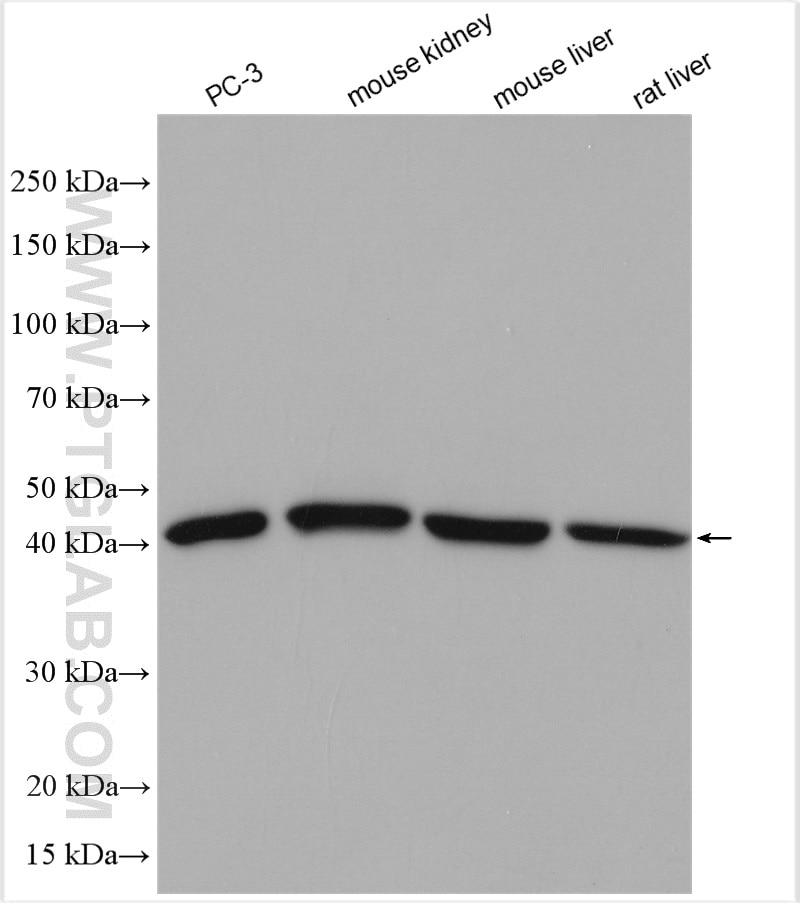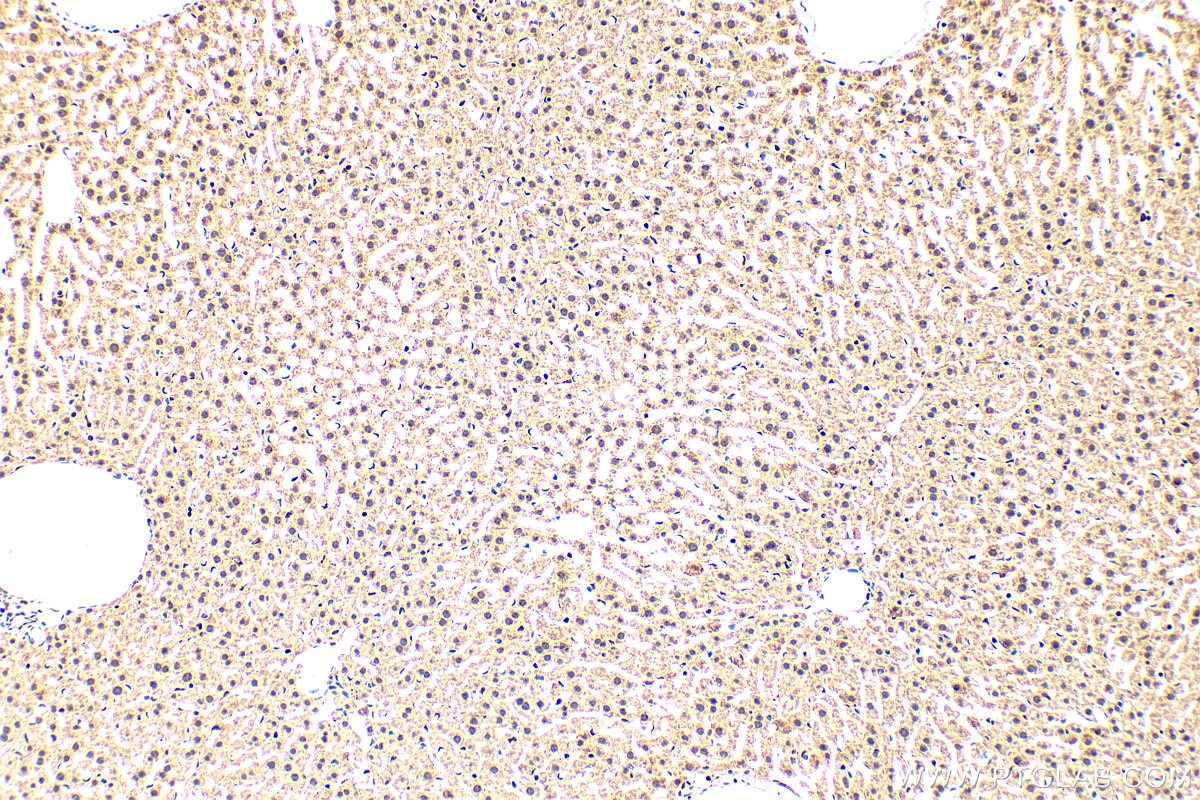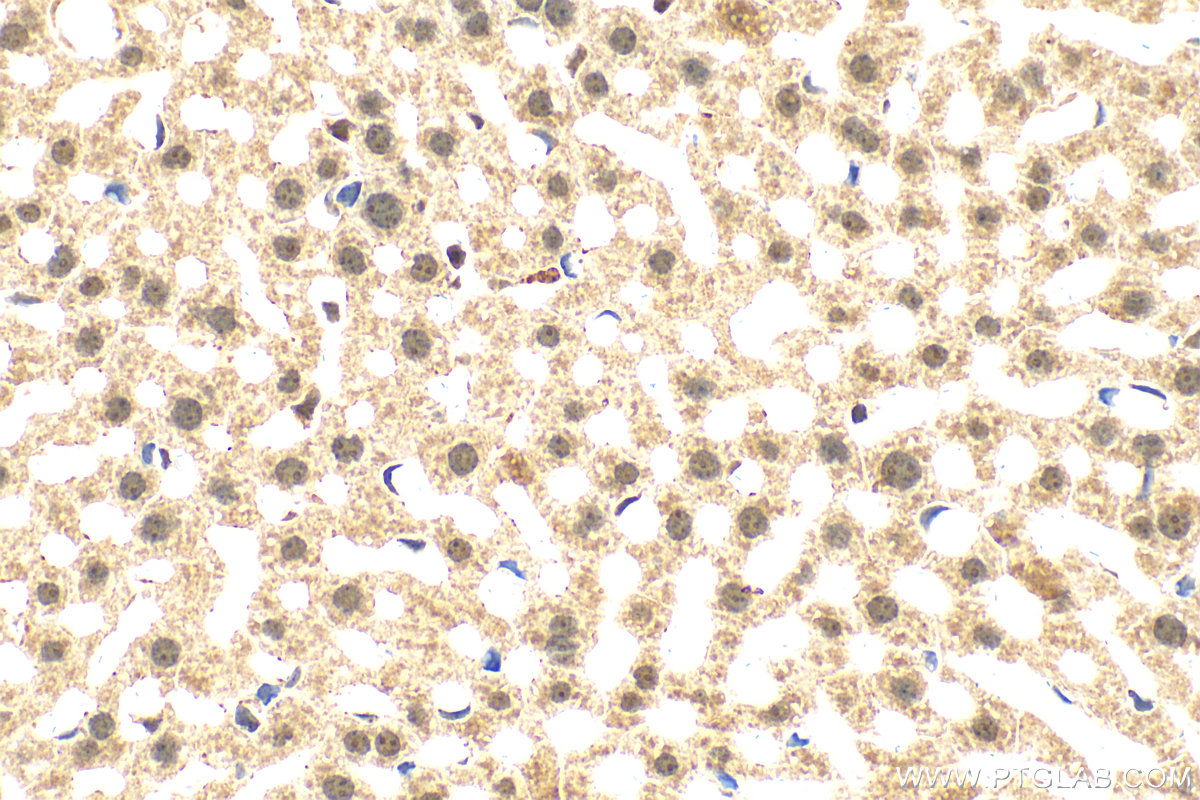Tested Applications
| Positive WB detected in | PC-3 cells, mouse kidney tissue, mouse liver tissue, rat liver tissue |
| Positive IP detected in | PC-3 cells |
| Positive IHC detected in | mouse liver tissue Note: suggested antigen retrieval with TE buffer pH 9.0; (*) Alternatively, antigen retrieval may be performed with citrate buffer pH 6.0 |
Recommended dilution
| Application | Dilution |
|---|---|
| Western Blot (WB) | WB : 1:1000-1:4000 |
| Immunoprecipitation (IP) | IP : 0.5-4.0 ug for 1.0-3.0 mg of total protein lysate |
| Immunohistochemistry (IHC) | IHC : 1:50-1:500 |
| It is recommended that this reagent should be titrated in each testing system to obtain optimal results. | |
| Sample-dependent, Check data in validation data gallery. | |
Published Applications
| KD/KO | See 3 publications below |
| WB | See 24 publications below |
| IHC | See 5 publications below |
| IF | See 1 publications below |
| IP | See 2 publications below |
Product Information
12994-1-AP targets SIRT7 in WB, IHC, IF, IP, ELISA applications and shows reactivity with human, mouse, rat samples.
| Tested Reactivity | human, mouse, rat |
| Cited Reactivity | human, mouse, rat |
| Host / Isotype | Rabbit / IgG |
| Class | Polyclonal |
| Type | Antibody |
| Immunogen |
CatNo: Ag3656 Product name: Recombinant human SIRT7 protein Source: e coli.-derived, PGEX-4T Tag: GST Domain: 1-400 aa of BC017305 Sequence: MAAGGLSRSERKAAERVRRLREEQQRERLRQVSRILRKAAAERSAEEGRLLAESADLVTELQGRSRRREGLKRRQEEVCDDPEELRGKVRELASAVRNAKYLVVYTGAGISTAASIPDYRGPNGVWTLLQKGRSVSAADLSEAEPTLTHMSITRLHEQKLVQHVVSQNCDGLHLRSGLPRTAISELHGNMYIEVCTSCVPNREYVRVFDVTERTALHRHQTGRTCHKCGTQLRDTIVHFGERGTLGQPLNWEAATEAASRADTILCLGSSLKVLKKYPRLWCMTKPPSRRPKLYIVNLQWTPKDDWAALKLHGKCDDVMRLLMAELGLEIPAYSRWQDPIFSLATPLRAGEEGSHSRKSLCRSREEAPPGDRGAPLSSAPILGGWFGRGCTKRTKRKKVT Predict reactive species |
| Full Name | sirtuin (silent mating type information regulation 2 homolog) 7 (S. cerevisiae) |
| Calculated Molecular Weight | 400 aa, 45 kDa |
| Observed Molecular Weight | 45 kDa |
| GenBank Accession Number | BC017305 |
| Gene Symbol | SIRT7 |
| Gene ID (NCBI) | 51547 |
| RRID | AB_10644276 |
| Conjugate | Unconjugated |
| Form | Liquid |
| Purification Method | Antigen affinity purification |
| UNIPROT ID | Q9NRC8 |
| Storage Buffer | PBS with 0.02% sodium azide and 50% glycerol, pH 7.3. |
| Storage Conditions | Store at -20°C. Stable for one year after shipment. Aliquoting is unnecessary for -20oC storage. 20ul sizes contain 0.1% BSA. |
Background Information
SIRT7 (NAD-dependent deacetylase sirtuin-7), also known as SIR2L7, is a member of the class IV sirtuin family and is localized to the nucleolus. Expressed throughout the body, SIRT7 associates with rDNA genes where it interacts with histones and acts as a positive regulator of RNA polymerase I (Pol I). SIRT7 is a probable NAD-dependent deacetylase whose expression is upregulated in thyroid carcinoma cells. Overexpression of SIRT7 increases Pol I-mediated transcription, thereby speeding cell growth and contributing to the development of cancer.
Protocols
| Product Specific Protocols | |
|---|---|
| IHC protocol for SIRT7 antibody 12994-1-AP | Download protocol |
| IP protocol for SIRT7 antibody 12994-1-AP | Download protocol |
| WB protocol for SIRT7 antibody 12994-1-AP | Download protocol |
| Standard Protocols | |
|---|---|
| Click here to view our Standard Protocols |
Publications
| Species | Application | Title |
|---|---|---|
Cell Metab Elevation of JAML Promotes Diabetic Kidney Disease by Modulating Podocyte Lipid Metabolism. | ||
Nat Commun Sirt6 deficiency exacerbates podocyte injury and proteinuria through targeting Notch signaling. | ||
Aging Cell Lycorine hydrochloride suppresses stress-induced premature cellular senescence by stabilizing the genome of human cells. | ||
Redox Biol A new FGF1 variant protects against adriamycin-induced cardiotoxicity via modulating p53 activity. | ||
Oxid Med Cell Longev SIRT7 Regulates Lipopolysaccharide-Induced Inflammatory Injury by Suppressing the NF-κB Signaling Pathway. | ||
PLoS Pathog KSHV vIL-6 promotes SIRT3-induced deacetylation of SERBP1 to inhibit ferroptosis and enhance cellular transformation by inducing lipoyltransferase 2 mRNA degradation |










